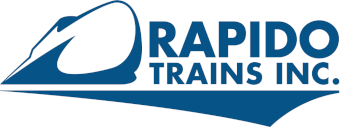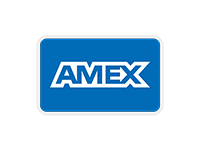by Craig Walker
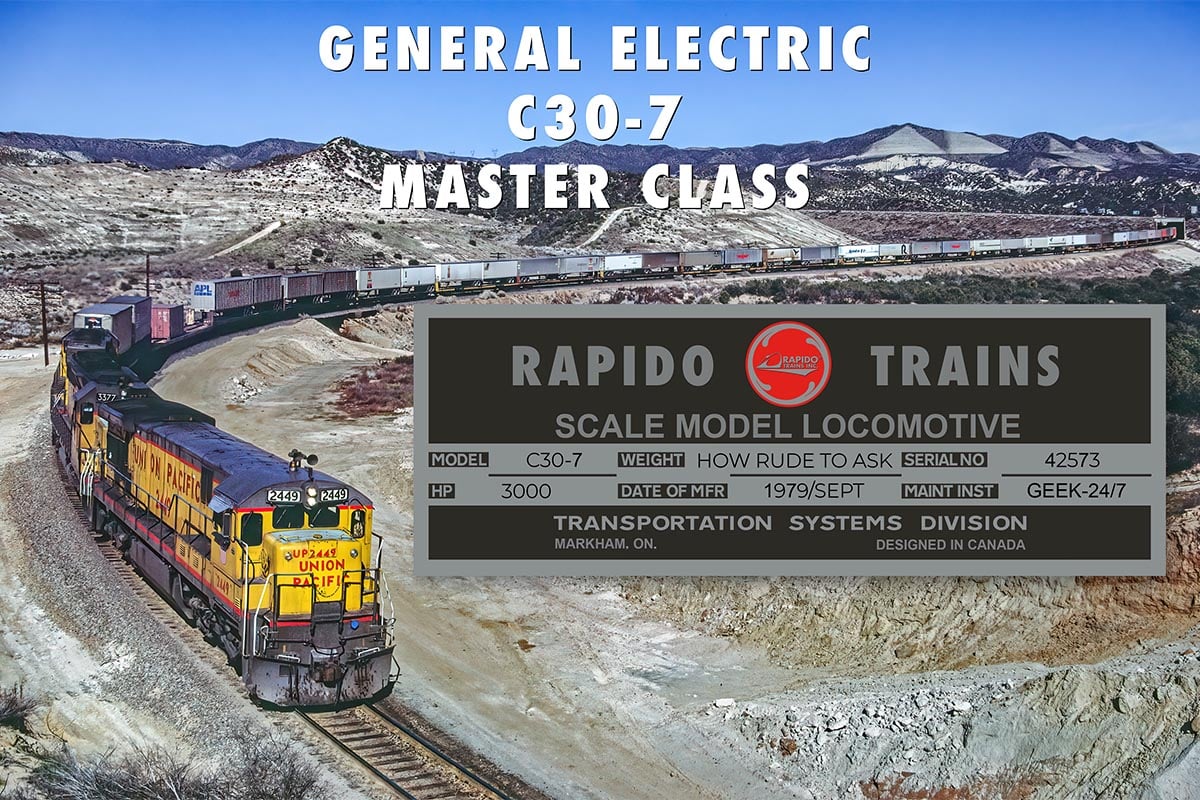
A westbound Union Pacific train descends Cajon Pass, California, behind UP C30-7 2449 on its way to Los Angeles on January 21, 1984. Craig Walker photograph.
The Next Generation of U-Boats
(But They Lost the “U”)
General Electric’s Universal Series of locomotives, dubbed “U-Boats” for short, began with the introduction of the U25B in 1959 to give dominant General Motors Electro-Motive Division some competition. As GE developed more improvements and variety to their line, later models such as the U23B, U23C, U28B and U28C led to the U30B and U30C. With a production span from January 1967 to September 1976, and sales of 592 U30Cs (plus six U30CG passenger versions), the U30C was by far the most successful of GE’s U-Boats.
But technological advances by EMD, naturally, prompted GE to keep pace, and in September 1976, GE unveiled the successor to the U30C at a railroad industry equipment show in Chicago IL when they displayed Burlington Northern C30-7 5500, a direct replacement for the popular U30C. And as with the Universal Series, the C30-7 was to become the most popular of GE’s new “Dash 7” line of diesel-electric locomotives.
The 3000-horsepower C30-7 had the same general appearance of the U30C, but internal improvements necessitated some external changes. As with the earlier U33C and U36C, these locomotives featured the wider “winged” radiators which overhang the walkways. To accommodate a relocation of the oil cooler, the long hood widens a bit with a step on each side just ahead of the exhaust stack location. As these locomotives are powered by a 16-cylinder FDL diesel engine there are eight power-assembly doors on the long hood. Another spotting feature, at least on most C30-7s, is a squared box on the upper front of the short hood (nose), similar to what was on those earlier U-Boats equipped with nose headlights. On those C30-7s without a nose light (which was most of them), there is an uneven octagonal plate riveted on the front. The nose also had louvers and grilles not found on the earlier GE diesels. The C30-7s rode on either Rockwell or Adirondack trucks, which railroads would order with a variety of brake cylinders locations and shock absorbers (snubbers) to suit their needs. Internally, the cab was redesigned with the AAR standard control stand, and an electric (rather than the earlier hot-water heated cab heater). The air compressor was relocated to inside the engine compartment from the radiator area. The space behind the cab previously dedicated to a steam generator (which few GE’s received) became the crew’s restroom, accessible from an exterior door. Many of the electrical relays and control modules that were formerly under the cab were also relocated to this area behind the cab.
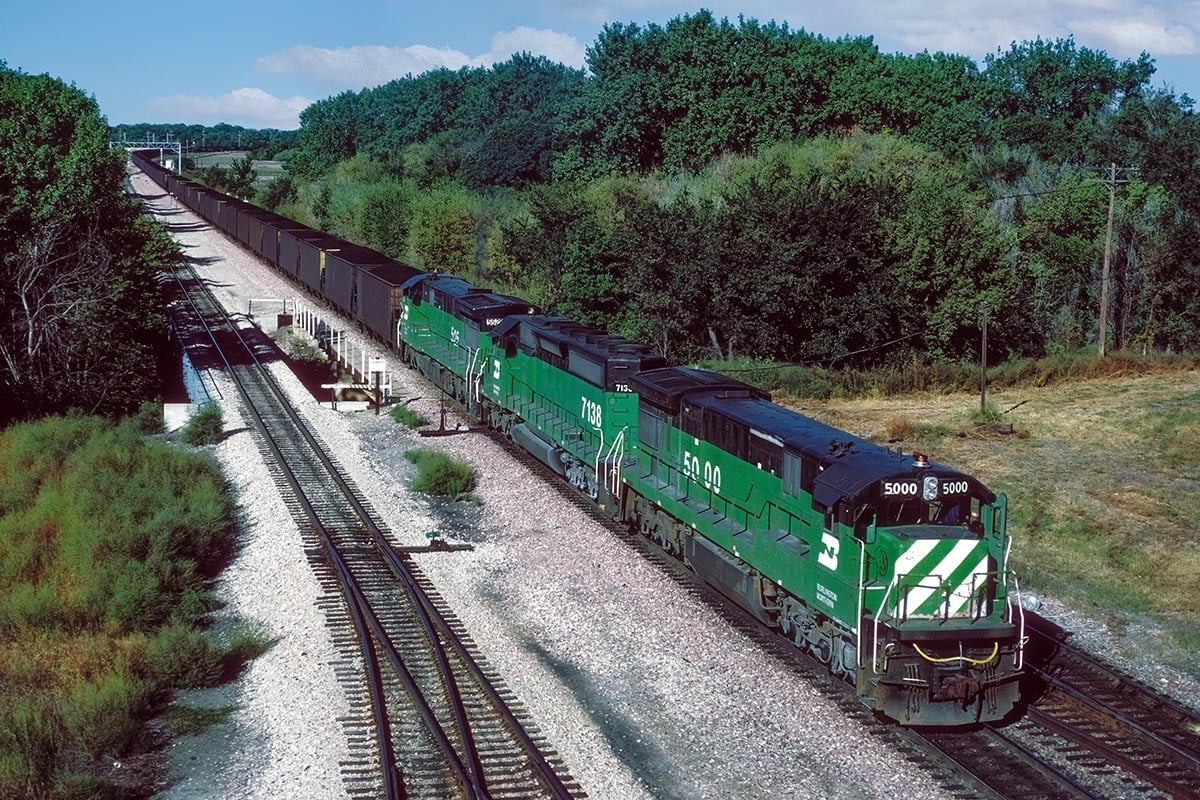
The very first General Electric C30-7, Burlington Northern 5500, leads an eastbound coal train through the small town of Ravenna, Nebraska, on September 23, 1990. This is one of a small number of C30-7s built without the box on the nose, and the only one of BN’s 230 C30-7s without this box. David M. Johnston photograph, Kevin EuDaly collection
General Electric’s C30-7 was constructed from September 1976 until May 1986.
GE’s U30C was a popular locomotive for coal-hauling railroads, and those sales continued with the new C30-7 as Burlington Northern and Union Pacific each acquired large fleets (242 C30-7s to the BN, and 140 for UP). Coal hauler Norfolk & Western picked up 80.
The Atchison Topeka & Santa Fe also purchase a sizable fleet of 157 locomotives. Two of the railroads operating under the Family Lines umbrella purchased C30-7s, with Louisville & Nashville acquiring 44 and Seaboard Coast Line opting for 51. Conrail purchased just 10 C30-7s, but later bought 50 of the C30-7A, becoming the only purchaser of this variation, built from May through June 1984.
The C30-7 was also purchased for railroads in México, with Ferrocarril del Pacífico (FCP) rostering 30, and Nacionales de México acquired nearly 300 units, making the C30-7 the largest fleet of diesels on the NDM, and twice as large as the next largest fleet (125 GP38-2s).
As might be suspected, mergers come into play as well, with BN’s fleet ending up as part of the Burlington Northern Santa Fe Railway, L&N and SCL locos going to Seaboard System, and then to CSX Transportation. Norfolk Southern’s C30-7s were absorbed into Norfolk Southern. FCP’s joined NDM’s roster. Other C30-7s were sold by the Class 1 railroads to either locomotive leasers or smaller railroads. For example, 57 of Santa Fe’s C30-7s were traded back to GE for an order of Dash 8-40Bs, and GE then placed these into their lease fleet. ATSF also sold some of their C30-7s to CR as well. These were then painted blue and had CRL (for Conrail Leasing, apparently, although that reporting mark belongs to Chicago Rail Link), and numbered in the 500s. Or, more accurately, in the 0500s, as they placed a zero as the first digit. Eventually, the “L” was removed (usually in an obvious manner) and these became Conrail 500-568.
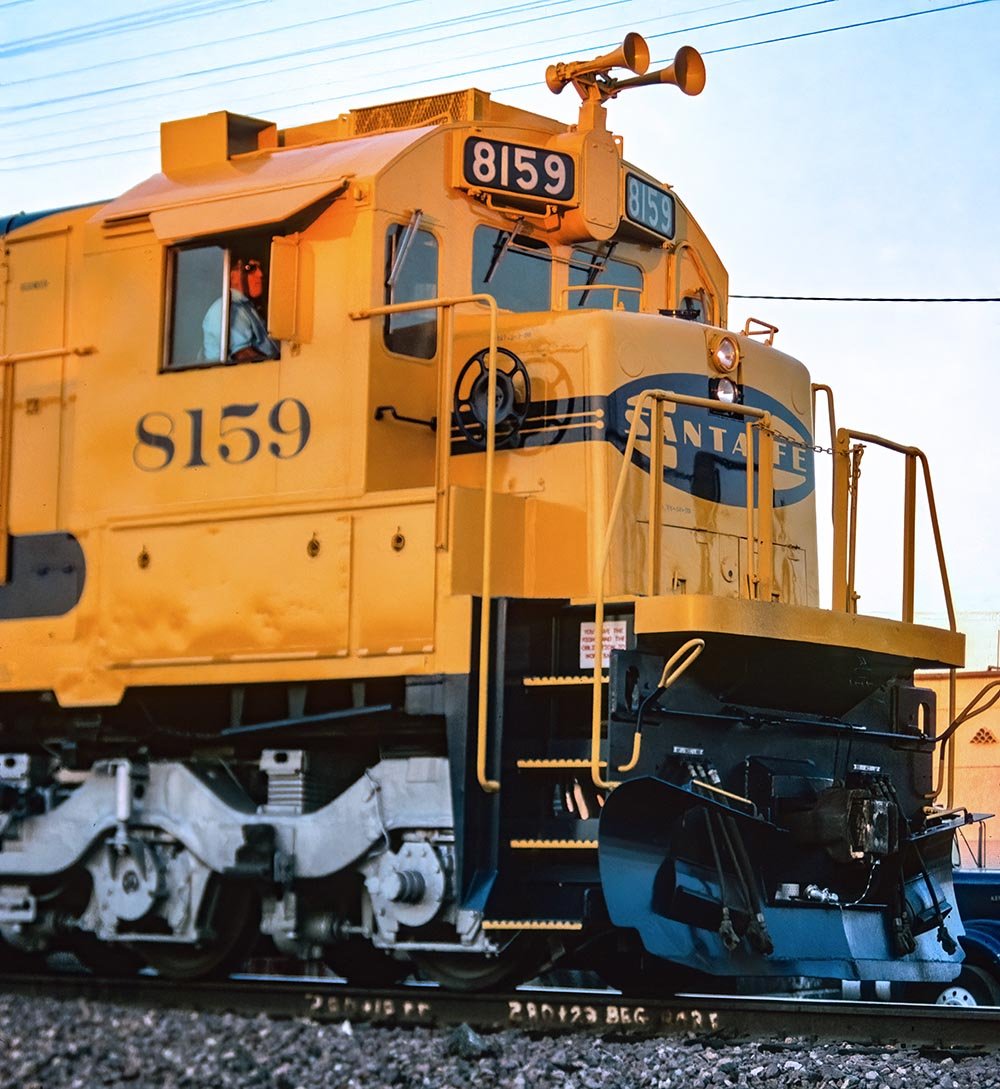
Santa Fe C30-7 8159 is among a group constructed by General Electric without the box in the nose. When photographed passing through Orange CA on its way to San Diego in November 1990, it had its headlight relocated from between the numberboards, as built, to a vertical position in the nose. This was a modification being made to all Santa Fe road power at this time in order to decrease glare reflecting back into the crew members’ eyes when snow is falling. Craig Walker photograph
The initial C30-7 owners were:
| Railroad | Road Numbers | Model | Quantity | Heritage | Notes |
|---|---|---|---|---|---|
| AT&SF | 8010-8152 | C30-7 | 143 | ||
| AT&SF | 8153-8166 | C30-7 | 14 | No rectangular box on the nose; 2 window cab | |
| BN | 5000 | C30-7 | 1 | No rectangular box on the nose | |
| BN | 5001-5141 | C30-7 | 141 | ||
| BN | 5500-5599 | C30-7 | 100 | ||
| BNSF | 5000 | C30-7 | 1 | ex-BN 5000 | No rectangular box on the nose |
| BNSF | 5001-5004, 5006-5031, 5033-5056, 5058-5072, 5074-5111, 5114-5135, 5137-5141 | C30-7 | 134 | ex-BN 5001-5004, 5006-5031, 5033-5056, 5058-5072, 5074-5111, 5114-5135, 5137-5141 | |
| BNSF | 5500-5531, 5533-5570, 5573-5575, 5578-5599 | C30-7 | 95 | ex-BN 5500-5531, 5533-5570, 5573-5575, 5578-5599 | HLCX lease |
| CR | 500-/-568 | C30-7 | unknown | ex-CRL 500-/-568 | |
| CR | 6600-6609 | C30-7 | 10 | ||
| CR | 6550-6599 | C30-7A | 50 | ||
| CRL | 500-568 | C30-7 | 69 | ex-ATSF 8010-/-8098 | |
| CSXT | 7000-7015 | C30-7 | 16 | ex-LN 7000-7015 | Gyralite removed; Headlight on nose |
| CSXT | 7016-7024 | C30-7 | 9 | ex-SCL 7016-7024 | Gyralite removed; Headlight on nose |
| CSXT | 7025-7031 | C30-7 | 7 | ex-SCL 7025-7031 | Gyralite removed; Headlight on nose |
| CSXT | 7032-7051 | C30-7 | 20 | ex-LN 7032-7051 | No cab light, Strobes on roof, Headlight on nose |
| CSXT | 7052-7059 | C30-7 | 8 | ex-SCL 7052-7059 | No cab light, Strobes on roof, Headlight on nose |
| CSXT | 7060-7061 | C30-7 | 2 | ex-SCL 7060-7061 | No cab light, Strobes on roof, Headlight on nose |
| CSXT | 7062-7069 | C30-7 | 8 | ex-LN 7062-7069 | No cab light, Strobes on roof, Headlight on nose; 2 window cab |
| CSXT | 7070-7094 | C30-7 | 25 | ex-SCL 7070-7094 | No cab light, Strobes on roof, Headlight on nose; 2 window cab |
| FCP | 434-459 | C30-7 | 26 | ||
| FXE | 3500-3596 | C30-7 | 97 | ex-NDM | |
| LN | 7000-7015 | C30-7 | 16 | Family Lines scheme; Gyralite on cab; Headlight on nose | |
| LN | 7032-7051 | C30-7 | 20 | Family Lines scheme; Gyralite on cab; Headlight on nose | |
| LN | 7062-7069 | C30-7 | 8 | No cab light, Strobes on roof, Headlight on nose; 2 window cab | |
| NDM | 434-459 | C30-7 | 26 | ex-FCP 434-459 | 2 window cab |
| NDM | 6700-6799 | C30-7 | 30 | ||
| NDM | 9600-9652 | C30-7 | 53 | 2 window cab | |
| NDM | 11001-11148 | C30-7 | 148 | 2 window cab | |
| NS | 8003-8082 | C30-7 | 80 | ex-NW 8003-8082 | |
| NW | 8003-8082 | C30-7 | 80 | ||
| SBD | 7000-7015 | C30-7 | 16 | ex-LN 7000-7015 | Gyralite removed; Headlight on nose |
| SBD | 7016-7024 | C30-7 | 9 | ex-SCL 7016-7024 | Gyralite removed; Headlight on nose |
| SBD | 7025-7031 | C30-7 | 7 | ex-SCL 7025-7031 | Gyralite removed; Headlight on nose |
| SBD | 7032-7051 | C30-7 | 20 | ex-LN 7032-7051 | Gyralite removed; Headlight on nose |
| SBD | 7052-7059 | C30-7 | 8 | ex-SCL 7052-7059 | No cab light, Strobes on roof, Headlight on nose |
| SBD | 7060-7061 | C30-7 | 2 | ex-SCL 7060-7061 | No cab light, Strobes on roof, Headlight on nose |
| SBD | 7062-7069 | C30-7 | 8 | ex-LN 7062-7069 | No cab light, Strobes on roof, Headlight on nose; 2 window cab |
| SBD | 7070-7094 | C30-7 | 25 | ex-SCL 7070-7094 | No cab light, Strobes on roof, Headlight on nose; 2 window cab |
| SCL | 7016-7024 | C30-7 | 9 | Family Lines scheme; Gyralite on cab; Headlight on nose | |
| SCL | 7025-7031 | C30-7 | 7 | Family Lines scheme; Gyralite on cab; Headlight on nose | |
| SCL | 7052-7059 | C30-7 | 8 | Family Lines scheme; No cab light, Strobes on roof, Headlight on nose | |
| SCL | 7060-7061 | C30-7 | 2 | Family Lines scheme; No cab light, Strobes on roof, Headlight on nose | |
| SCL | 7070-7094 | C30-7 | 25 | Family Lines scheme; No cab light, Strobes on roof, Headlight on nose; 2 window cab | |
| UP | 2400-2414 | C30-7 | 15 | ex-UP 2960-2974 | 2 window cab |
| UP | 2415-2499 | C30-7 | 85 | No rectangular box on the noses of 2463, 2478 and 2492 | |
| UP | 2500-2539 | C30-7 | 40 | 2 window cab | |
| UP | 2960-2974 | C30-7 | 15 | 2 window cab |
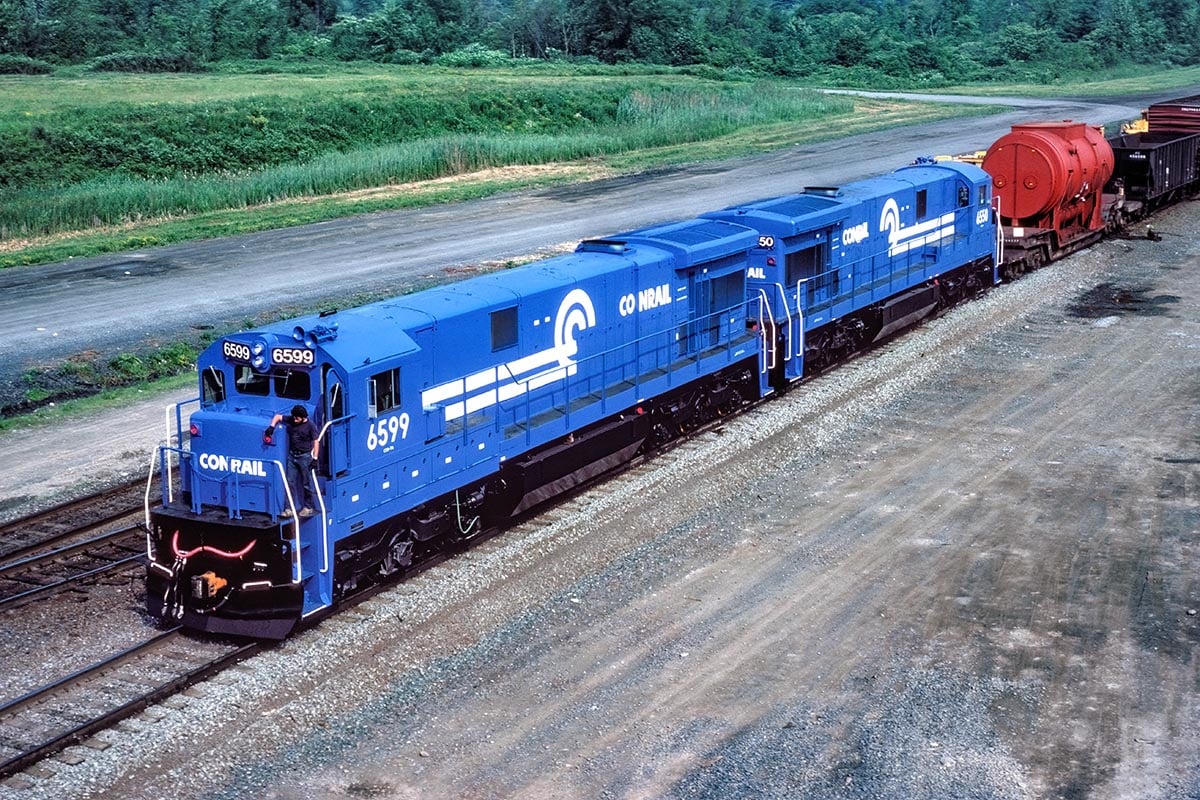
This angle of a pair of Conrail C30-7A locomotives provides a nice view of the cleanliness of the General Electric diesels’ roofs. These two diesels are C30-7A models, slightly different than the C30-7, but we can see the differences here: the red marker lights on the nose (which the crew member is helpfully point out). These red lights can also be found on the rear of CR 6550. Note, too, that the nose has no box on it. The 2-strap cab signal box, also installed on CR’s C30-7s, is clearly visible on the walkway behind the cab. CR 6599 also has the later 2-window cab, along with the different hood door pattern. These diesels were photographed in Selkirk NY on Independence Day 1984. James Conroy photograph, Kevin EuDaly collection
Notes about locomotives not listed in the roster (to keep it simple):
- Around 1990, many of Santa Fe's C30-7s were leased to CSX Transportation for an extended time.
- Immediately after then were striken from Conrail's active roster, CR 6600-6604 were leased to the Monongahela Railway.
- As railroads disposed of C30-7s, locomotive leasing companies picked them up. Some of these leasing companies were ATEL Leasing Corp. (ATGX), Big Dog Leasing (BDLX), FAIX Leasing (FAIX), GE Transportation Systems (GECX), Helm Financial Corporation (HLGX), Livingston Rebuild Center (LRCX), National Railway Equipment (NREX), Progress Rail Services Corp. (PRSX), Railcar Limited (RMGX) and Trinity Industries Leasing (TLLX). Fifty-seven of Santa Fe’s C30-7s were traded in to GE for newer power and GE then leased to other railroads in full ATSF paint but with small LEM initials on them. These were leased to various railroads, such as BN, C&NW, CSX, SP … and some were even leased back to the Santa Fe!
- A variety of shortlines purchased cast-off C30-7s, either directly from other railroads or through locomotive dealers, including Alberta RailNet (ARN), Central Michigan Railway (CMGN), Lake Superior & Ishpeming (LSI), Montréal, Maine & Atlantic (MMA), Nashville & Eastern Railroad (NERR), New Hope & Ivyland (NHRR), New York Susquehanna & Western (NYSW), Ohio Central (OHCR), Reading, Blue Mountain & Northern (RBMN)
- A fair number of GE C30-7s ended up becoming export locomotives, entering service on foreign railroads such as Brazil’s America Latina Logistica, Ferronorte Brasil and MRS Logistica.
- Many Santa Fe C30-7s were purchased by Conrail Leasing and numbered with three digit 500-series numbers. Oddly, these engines carried “CLR” above the numbers on the cab, although that reporting mark belongs to Chicago Rail Link. These engines were later made official Conrail engines, and retained these unusual (for locomotives) road numbers, but with a zero as the first of the four digits. Many later ended up as Union Pacific locomotives, and later Helm Leasing (HLCX) in UP paint.
- Transportación Ferroviaria Mexicana (TFM) purchased C30-7s from NDM/FNM.
- Kansas City Southern de México (KCSM) purchased C30-7s from NDM/FNM.
- Union Pacific designated several of their C30-7s as “B-Units,” including numbers 2402, 2474 and 2489. These locomotives’’ numbers had a “B” added to the roadnumber, such as B2402.
- Union Pacific renumbered many of their C30-7s into the 400s and 500s, beginning in October 1996. A total of 86 units were renumbered to 400-531 group to avoid conflict with GP38-3 units in 2400/2500 series leased from Helm Financial Corp; UP 2447 was renumbered to UP 445 on 28 October 1996 as the first unit completed, and UP 2465 was renumbered to UP 462 on 6 March 1999 as the last.
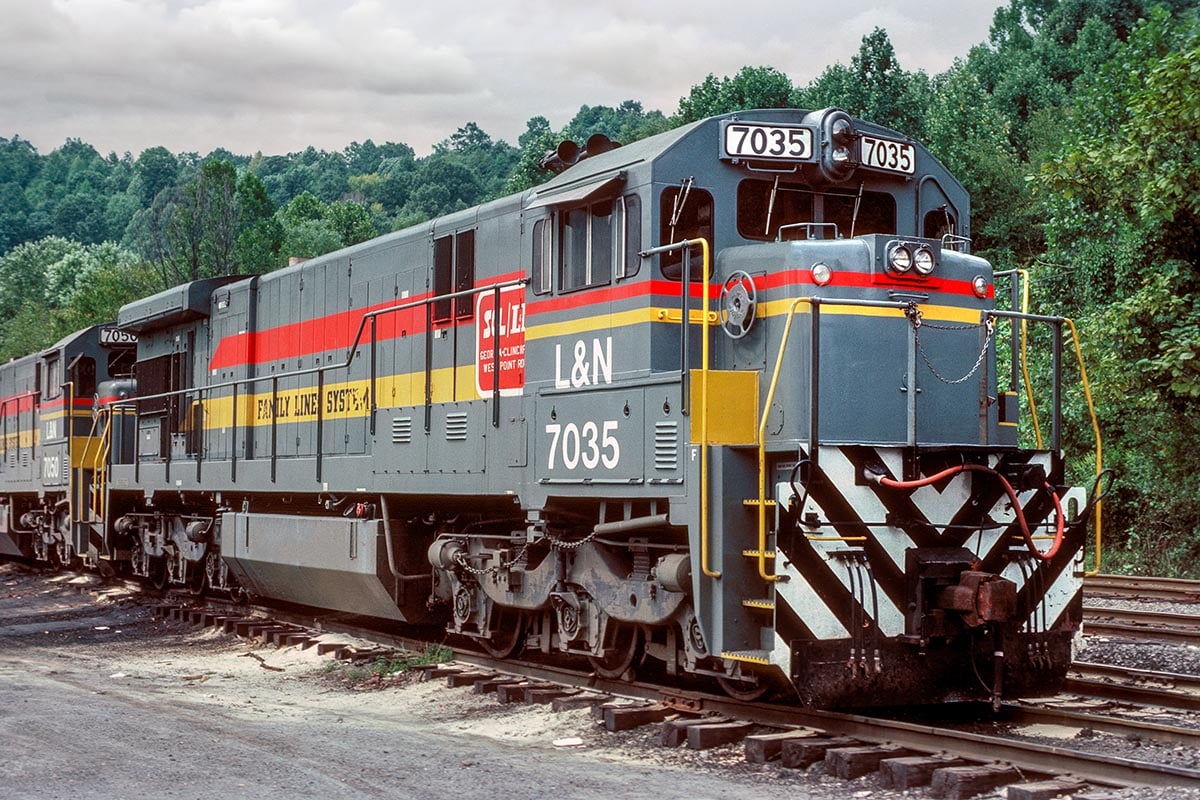
Louisville & Nashville’s C30-7s were ordered after the railroad became part of the Family Lines System (along with SCL, CRR, AWP, WRA and GA) in 1972, so it was a shame that these engines were not delivered in the classic gray and yellow L&N scheme. Still, this new scheme wasn’t as bad as some made it out to be. These locomotives, along with Seaboard Coast Line’s C30-7s, were delivered from 1979 through 1980 … and Family Lines Systems’ railroads were merged with the Chessie System railroads (B&O, C&O and WM) just a few years later, in 1982, when Seaboard System was created. This scheme and it’s hood stripes, however, allow a clear view of the jog to the rear of the engine room doors, where the hood gets a few inches wider. And, photographed in Loyall KY on September 20, 1980, L&N 7035 (and 7050 behind it) still have their oscillation Gyralites between the numberboards, which have been removed in the photo of SCL 7053 also found in this Master Class. A medium gray diesel with red and yellow striping and stark black and white pilots? It isn’t classic L&N, but it is attractive in its own right. F. David Petke photograph, Kevin EuDaly collection
On The Job
General Electric’s C30-7s were placed into a wide variety of services for their owners, from hauling heavy coal trains on BN, N&W and UP. ATSF operated them on intermodal trains. And all the railroads that owned them (ATSF, BN, CR, FCP, L&N, N&W, NDM, SCL and UP) put them to use on general merchandise freight trains.

Norfolk & Western’s 80 C30-7s were delivered in the road’s late-1970s black paint scheme with a simple NW on the hood. Several of these locomotives, including 8010, 8076, 8077, 8078, 8079 and 8080 were repainted in a Tuscan Red version of this scheme with Dulux (dark yellow) lettering in the early 1980s. Note, too, that the Norfolk & Western’s C30-7s were built with six brake cylinders per truck, rather than four, to assist with braking heavy coal trains in the Appalachian Mountains. N&W 8076 was found in the railroad’s Calumet Yard in Chicago, Illinois, in August 1981. Gregory J. Sommers photograph
A Brief Summation of Paint Schemes
Brief, as there are always variations not listed here…
Atchison Topeka & Santa Fe
- Delivered in the blue and yellow “Yellow Warbonnet” scheme.
- In anticipation of the proposed Southern Pacific Santa Fe (SPSF) merger, ATSF 8013, 8016, 8018, 8019, 8023, 8051, 8055, 8056, 8061, 8063, 8066, 8068, 8069, 8070, 8072, 8073, 8075, 8076, 8077, 8078, 8079, 8080, 8081, 8085, 8086, 8087, 8088, 8089, 8090, 8104, 8105, 8133, 8139, 8141, 8142, 8146, 8148, 8150, 8154, 8155, 8156, 8158, 8159, 8162, 8164 and 8165 were painted in the red, black and yellow “Kodachrome” scheme (but with only “SF” initials on them) in 1985 and 1986, before the ICC denied the merger.
Burlington Northern
- Delivered in BN Cascade Green and black with white nose striping
- Some repainted to the later BN “White Face” scheme beginning in 1989, applied to units 5004, 5019, 5032, 5049, 5057, 5067, 5074, 5078, 5098, 5113, 5114, 5516, 5118, 5538, 5548, 5556, 5558, 5563, 5565, 5568 and 5584.
- The White Face scheme was modified with a 2” white stripe separating the black and green in 1991, applied to units 5040, 5047, 5053, 5054, 5081, 5516, 5521, 5561, 5571, 5595 and 5599.
Burlington Northern Santa Fe (laterBNSF Railway)
- Patched with BNSF reporting marks and new roadnumber on old ATSF paint.
- Patched with BNSF reporting marks on old BN paint.
- Full repaint into BNSF’s first green and orange scheme (Heritage I): 5165, 5174, 5175, 5177.
Conrail
- Delivered in Conrail Blue and black.
- Some C30-7s received the Conrail Quality scheme, including (but not limited to) C30-7As 6551, 6553, 6563, 6570.
- 0500-series Second-hand C30-7s from other roads were repainted Conrail Blue and black with CRL initials on the cab side above the roadnumber.
- 0500-series Second-hand C30-7s from other roads were later modified with a blue patch (which didn’t match the paint) covering the “L” in the “CRL” marking.
CSX Transportation
- Patched Family Lines schemes or Seaboard System scheme
- CSX’s earliest scheme, known as the B scheme (1987+), is a gray locomotive with blue roof, upper half of the cab, side sill and walkways, and everything below that (trucks, fuel tank, etc.). We know that C30-7 7026 was painted this way.
- CSX’s G scheme (1988+), a solid gray locomotive with blue lettering and trucks, fuel tank, etc. below the walkway. CSXT 7013, 7048, 7064 and 7080 are confirmed to have been in this scheme.
- CSX’s YG scheme (1988+), a solid gray locomotive with blue lettering and trucks, fuel tank, etc. below the walkway, and yellow hood ends. CSXT 7018 and 7071, at least, wore this scheme.
- CSX 7024 wore what appeared to be the YG scheme, but with additional yellow replicating, sort of, the later YN2 scheme’s yellow. In other words, the yellow angles back on the nose’s sides and continues down the side sill; http://www.trainweb.org/csxphotos/photos/unusual/7024m.jpg.
- CSX’s Y scheme (1989+) of a gray locomotive with blue roof and upper half of the cab, and yellow ends and side sill. Locomotives known to have worn this scheme include 7005.
- CSX’s YN2 (or “Bright Future”) blue, yellow and gray scheme (1990+) in which the nose is yellow, the cab is blue and the hood is mainly gray with a blue and yellow stripe along the lower portion. An incomplete list of units in this scheme includes: 7000, 7001, 7007, 7010, 7011, 7014, 7017, 7021, 7024, 7028, 7029, 7034, 7035, 7039, 7040, 7042, 7046, 7051, 7052, 7058, 7063, 7072, 7073, 7077, 7082, 7088, 7090 and 7091 (and, no doubt, many others).
Family Lines
(not a railroad, but the umbrella name for Louisville & Nashville and Seaboard Coast Line railroads [along with Atlanta & West Point, Clinchfield, Georgia Railroad and Western Railway of Alabama])
- Delivered in Family Lines’ gray, red and yellow scheme with either L&N or SCL reporting marks on the cab, with the roadnumber on the battery box doors underneath the cab.
Nacionales de México
- Delivered in the dark green and red scheme, with black underframes and silver lettering
- Some repainted into the later FNM 2-tone blue scheme with orange striping and lettering
Norfolk & Western
- Delivered in the black scheme with the large white NW initials on the long hood.
- Maroon with Dulux Gold lettering and large NW initials on the long hood: 8010, 8076, 8077, 8078, 8079 and 8080
Norfolk Southern
- These former N&W locomotives were repainted into NS’s first paint scheme.
Seaboard System
- Family Lines scheme with patched reporting marks
- Full SBD gray, yellow and red scheme
Union Pacific
- Delivered in the traditional UP Armor Yellow and Harbor Mist Gray with Aluminum truck sideframes, with the UP Shield on the cab side.
- Beginning in 1980, a 20” road number was applied to the cab with a small shield underneath, and a larger shield on the nose and Harbor Mist Gray truck sideframes.
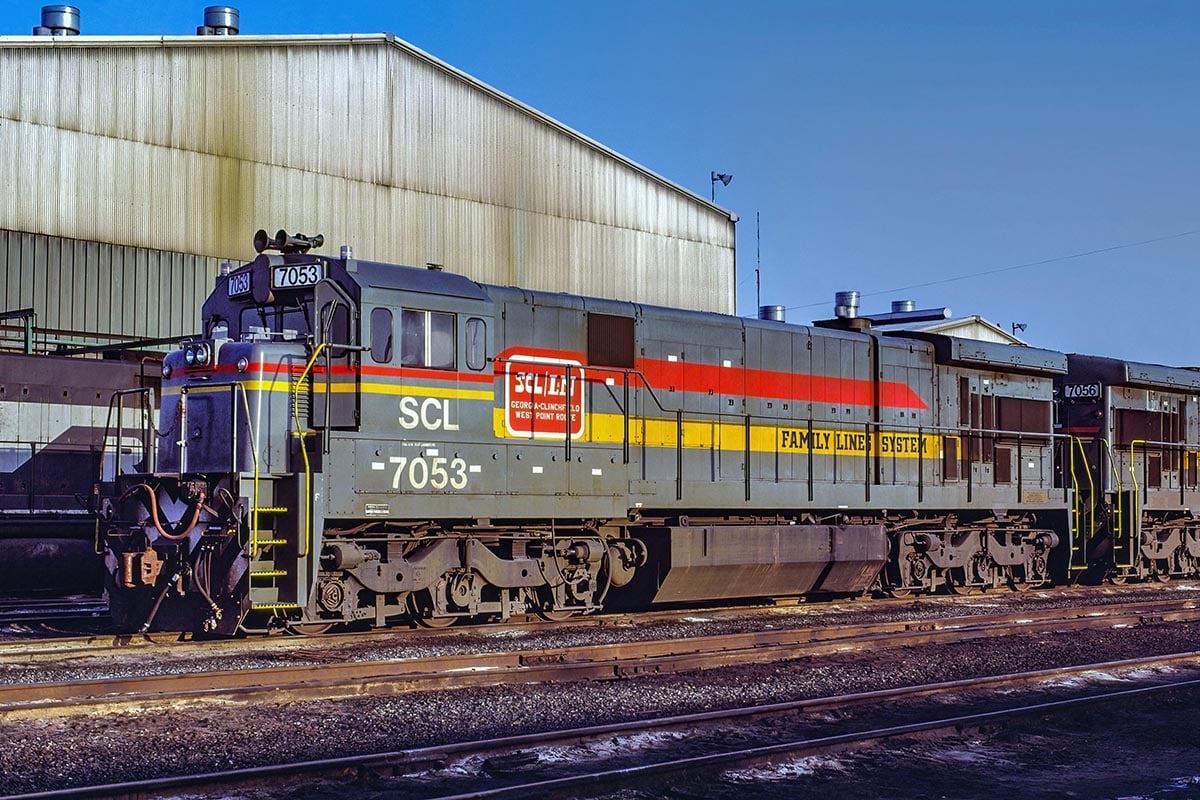
Seaboard Coast Line C30-7 7053, constructed in March 1980, is in the first group of Family Lines engines delivered with strobes lights on the cab rather than the Gyralight between the numberboards, a cost-cutting move by the railroad beginning with all power delivered from 1980 onward. Photographed in Richmond, Virginia. Douglas G. Walker photograph
Variations … There are Always Variations
Of the 1078 C30-7s constructed by General Electric, there were some differences that showed up throughout production, or as requested by the various railroads:
- As usual, a wide variety of air horns, radio antennas, snowplows, bell styles and placement were found on C30-7s. Checking photos is advisable.
- The very first C30-7 built (BN 5000) was missing the early Dash 7-style box on the nose, very similar to the earlier “U-Boat” noses. Most production C30-7s after the first featured this box on the nose, until some very late production units: Some of UP’s we missing this (UP 2463, 2478 and 2492, and possibly others) and Santa Fe 8153-8166 were also missing it.
- Regarding that box on the nose mention previously, some railroads ordered their C307s equipped with oscillating Gyralights above the cab, between the numberboards, requiring the twin sealed-beam headlight to be mounted horizontally on the nose’s box. L&N’s units were so equipped, as were those owned by SCL.
- However, from SCL 7052 on (SCL 7052-7061, N&N 7062-7069 and SCL 7070-709), the Gyralight was not included on the Family Lines’ C30-7s, replaced by a pair of cab-mounted strobe lights.
- Some of the last C30-7s built (for Santa Fe and a few for Union Pacific) lost the rectangular box on the nose, giving the nose a more pleasing rounded look similar to the earlier U-Boats (but only those without nose lights, of course).
- In the 1990s the Santa Fe Railway began relocating locomotive headlights from above the cab to the locomotive’s nose. This provided the crews with a better view when it was snowing, as the upper headlight caused light bouncing off the snowflakes to reflect back into the crews’ eyes. The light in the lower position improved visibility in snowy conditions, as well as in fog or other hazy weather.
- GE’s C30-7s were delivered with either Rockwell or Adirondack trucks. And on either of these, there are further variations regarding the placement of the brake cylinders (high or low mounts) and the number of brake cylinders (usually 2 per sideframe, but sometimes 3). Also, shock absorbers (snubbers) could be located on the two outer axles, or on the center axle. Plus, there were at least 3 different types of snubbers.
- GE offered two cabs on the C30-7: One with just the sliding windows on the side, and another with additional gasketed windows fore and aft of the sliding windows. Originally all C30-7s had the “4 window” cab, but beginning with units delivered in July 1980 (L&N 7062 was the first), the cabs had the “2 window” variation. Later, many roads painted, and later still, plated over the non-sliding gasketed cab-side windows.
- Anticlimbers were found on C30-7s owned by ATSF, BN and CR (including their C30-7As)
- Conrail’s C30-7s had a 2-strap cab signal box mounted on the conductor’s side (the locomotive’s left side) on the walkway behind the cab.
- Conrail’s 50 C30-7A locomotives featured a number of external differences from the earlier C30-7s, including no box on the nose, but instead there were red marker lights on the nose and rear, different hood door configurations (6 power assembly access door, instead of 8, due to the use of 12-cylinder FDL engine) and alternate door latch positioning.
Thanks to David Patch, Josh Anderchek, Tony Cook, Jeff Lassahn, John Frantz, Bob Graham, Ron Hawkins and Greg Sommers for their assistance!
References:
- Marre, Louis and Paul K. Withers. The Contemporary Diesel Spotter’s Guide, Year 2008 Edition, Withers Publishing, 2008. ISBN 1-881411-53-2
- McDonnell, Greg. Locomotives, The Modern Diesel & Electric Reference. The Boston Mills Press, 2015. ISBN 1-77085-609-9
- Diesel Era magazine, May/June 1992
- Locomotive Rosters: https://www.thedieselshop.us/
- GE C30-7 Roster: http://thedieselshop.us/GE_C30-7.HTML
- BNSF C30-7 Information: http://www.qstation.org/C30-7/html/bnsfc30-7.html
- Conrail C30-7 Information: http://crcyc.railfan.net/locos/ge/7c30/c307proto.html
- Conrail C30-7A Information: http://crcyc.railfan.net/locos/ge/7c30a/c307aproto.html
- Former ATSF C30-7s: http://atsf.railfan.net/sfkodcrm/c30-7e.html
- Union Pacific C30-7 Information: https://utahrails.net/up-diesel-roster/up-diesel-roster-37.php
